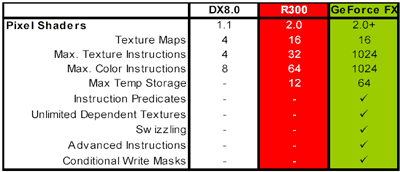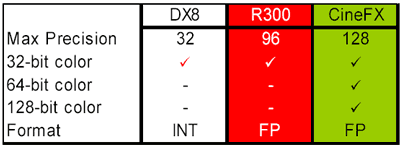NVIDIA Introduces GeForce FX (NV30)
by Anand Lal Shimpi on November 18, 2002 10:13 AM EST- Posted in
- GPUs
NVIDIA's got 8 pipes too
Just as we mentioned in our technology preview of ATI's R300, most DX9 based architectures will feature 8 rendering pipelines. The GeForce FX is no exception to the rule and it implements a virtually identical set of 8 128-bit floating point pixel rendering pipelines.
These fully floating point pipelines are where the majority of the GeForce FX's transistor budget is spent, but they are also what make the cinematic quality effects (or FX, if you will) possible. Once again, we've already explained the benefits of floating point color here.
Just like the Radeon 9700 Pro, the GeForce FX can only process one texture per pixel pipeline in a single clock, giving the GeForce FX no inherent fill rate advantage over the Radeon. NVIDIA makes up their performance advantages in their memory architecture, higher core clock speeds and overall efficiency. The GeForce FX, like the Radeon 9700 Pro, can process 16 textures per pixel, just not in a single clock which is often misunderstood.
Once again, NVIDIA went above and beyond the DX9 specification for pixel shaders and introduced what they call their Pixel Shader 2.0+ support. The advantages here continue to be in support for more instructions in shader programs among other things:

And once again we see that the GeForce FX part is more of an enabling product, with the real demand for end users to have this sort of "beyond PS2.0" support not arriving until at least a year from now.

GeForce FX also supports greater color precision than any competing product










0 Comments
View All Comments